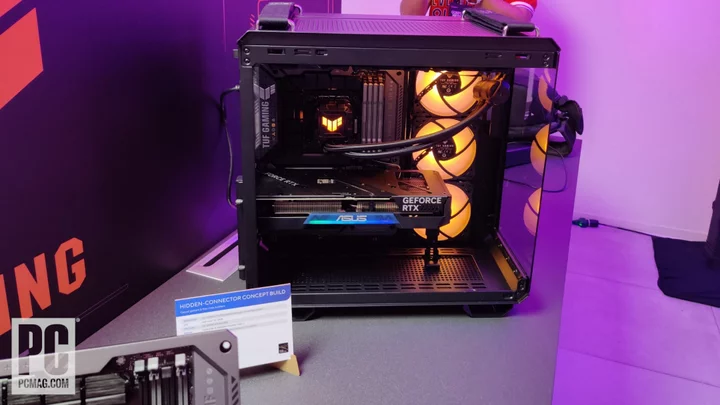PCs are ever evolving, but when it comes to building one, some bits haven't changed in decades. Parts change over time, and so might their placement, but in the end, you still end up wiring everything together. At that always leaves some cables hanging out and obstructing the view of your expensive new hardware, no matter how much care you take.
Asus has taken aim at this problem in a revolutionary concept PC that largely (though not entirely!) works around this issue and leaves you with a cleaner-looking gaming PC. It's dubbed the "Hidden Connector Concept Build," shown at Computex 2023, and we got a first look.
That said, though it's only a concept and not a commercially viable product at the moment, it raises some new questions while solving some age-old problems.
Wait...Is This Project Avalon 2.0?
The stagnation in fundamental PC-building precepts, in many ways, has helped to make building a PC less daunting, as there's a vast array of long-standing information out there. Plus, if you’ve ever built a PC before, you more or less know how to do it now. But in some key areas, the process could be improved to make building a system easier and to create a cleaner-looking finished build.
Certain things aren’t so easy to change, notably all the wiring that connects the parts together. Asus has been thinking over ways to take building a PC to the next level for some time now. It introduced what it called Project Avalon back in 2016, a unique concept system that attempted to make changing components easier than ever.
That idea never quite came to fruition, but now Asus is showing off a different, far less ambitious, yet vaguely similar system concept. We don’t get a cool code-name for this one, alas. Whereas the original Project Avalon changed many aspects of the PC-building process, this new design concept doesn’t change nearly as much. It consists of a custom-built case, motherboard, and graphics card, all of which resemble standard components, but with some key tweaks.
The Asus TUF motherboard used for this concept PC is unique in its placement of internal headers and power connectors on the back of the motherboard, like so...
We've seen occasional hints of this, especially with M.2 slots, and on custom motherboards for mini-PCs, but this is highly irregular for a full-size motherboard. On a standard motherboard, you can’t add much of anything to the back of the board because the motherboard always mounts to a mounting tray inside of a PC case. This would block access any ports on the underside, preventing you from plugging anything into them.
As a result, to support a motherboard with most of its internal headers shifted to the underside of the board, you’d also need a case specifically designed to support plugging in things from below. And this is exactly what Asus has created.
The system is labelled as part of Asus' TUF Gaming line, and the concept design features an Intel LGA 1700-socket motherboard, running an Intel Z790-series chipset. This was mounted into a custom case with an Asus Nvidia GeForce RTX graphics card.
Note that extra edge connector on the card in the images above and below. The case and motherboard design Asus is using for this concept PC is largely similar to MSI’s Project Zero concept PC and Gigabyte’s Project Stealth PC, the latter of which is already available for sale.
Though Asus’s concept system is similar to the ones from MSI and Gigabyte, Asus has taken the design a step further by also hiding away PCI Express graphics-card cables. Asus has done this by designing a specialized graphics card with that second edge connector, which fits into a custom slot on the motherboard...
The power supply's PCIe cables are then plugged into the underside of the motherboard, which feeds the power up to the graphics card through this connector and gives you an even cleaner finished build. Given the protruding 12-pin connector on late-model Nvidia cards, this cable cleanup is more appealing than ever. The other connectors to the PSU, such as the 24-pin and CPU-power, also get plugged in from below, along with any SATA devices and all the headers big and small: USB front-panel, front-panel audio, and the header cluster for switches and case LEDs.
Great for System Buyers, But Is It Great for PC Builders?
Asus’ new design has several things going for it. It will give you a decidedly cleaner-looking finished build, and it also would likely make building a system easier. But it has several problems that are difficult to overcome, too. First and foremost: If executed in this way, parts from this system would not be easily moved to another system. That graphics card is only going to work in this one PC, or another built on the same Asus design concept. Nor will it be easy to replace broken parts if you need to limit choice to this small subset of components.
This becomes troublesome when it comes time to upgrade to a new graphics card or a new motherboard. Unless Asus starts wide-scale production of parts to support this design, or motherboard and chassis vendors get together to work out some placement standards for this kind of design, you’d have to buy another new PC, or at least a subset of compatible parts, in order to upgrade. Even if Asus were to shift this concept into heavy production, you’d be tied to Asus and unable to buy graphics cards or motherboards from competing manufacturers if that cross-vendor coordination doesn't happen.
Of course, as a concept, there's no guarantee this will see the light of day. And to be sure, it's an interesting and worthwhile design for a full pre-built PC. If you don’t know how to build a PC and don’t want to learn or upgrade your system yourself, a pre-built version of this would deliver the positive of having a very cleanly built system without any of the cons. If you do intend, however, down the line to upgrade your PC yourself, we’d recommend giving this ecosystem some time to cook—assuming it ends up on the menu at all!—before jumping in.









